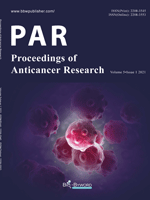Abstract
Objective: The purpose of this study is to explore the role of sphingosine kinase 2 (SphK2) in the treatment of glioma, which is the most common primary tumor in the central nervous system. Methods: A total of 82 patients were included in this study, with 27 cases in the control group and 55 cases in the glioma group; the expressions of SphK2 and gp130 in the two groups were compared by immunohistochemical method, and the correlation between the two factors was analyzed. Results: Both SphK2 and gp130 were upregulated in the glioma group, and the two factors were significantly correlated. Conclusion: The high expression of SphK2 may play an important role in the occurrence, development, and diagnosis of glioma.
References
Eyüpoglu I, Buchfelder M, Savaskan N, 2013, Surgical Resection of Malignant Gliomas-Role in Optimizing Patient Outcome. Nature Reviews Neurology, 9: 141-151.
Cuddapah VA, Robel S, Watkins S, et al., 2014, A Neurocentric Perspective on Glioma Invasion. Nature Reviews Neuroscience, 15(7): 455-465.
Bellail AC, Hunter SB, Brat DJ, et al., 2004, Microregional Extracellular Matrix Heterogeneity in Brain Modulates Glioma Cell Invasion. International Journal of Biochemistry & Cell Biology, 36(6): 1046-1069.
Onishi M, Ichikawa T, Kurozumi K, et al., 2011, Angiogenesis and Invasion in Glioma. Brain Tumor Pathology, 28(1): 13-24.
Sanna MG, 2004, Sphingosine 1-Phosphate (S1P) Receptor Subtypes S1P1 and S1P3, Respectively, Regulate Lymphocyte Recirculation and Heart Rate. Journal of Biological Chemistry, 279(14): 13839-13848.
Maceyka M, Sankala H, Hait NC, et al., 2005, SphK1 and SphK2, Sphingosine Kinase Isoenzymes with Opposing Functions in Sphingolipid Metabolism. Journal of Biological Chemistry, 280(44): 37118-37129.
Shida D, Takabe K, Kapitonov D, et al., 2008, Targeting SphK1 as a New Strategy Against Cancer. Current Drug Targets, 9(8): 662-673.
Kajimoto T, Okada T, Miya S, et al., 2013, Ongoing Activation of Sphingosine 1-Phosphate Receptors Mediates Maturation of Exosomal Multivesicular Endosomes. Nature Communications, 4: 2712.
Figueroa J, Phillips LM, Shahar T, et al., 2017, Exosomes from Glioma-Associated Mesenchymal Stem Cells Increase the Tumorigenicity of Glioma Stem-like Cells via Transfer of miR-1587. Cancer Research, 77(21): 5808-5819.
